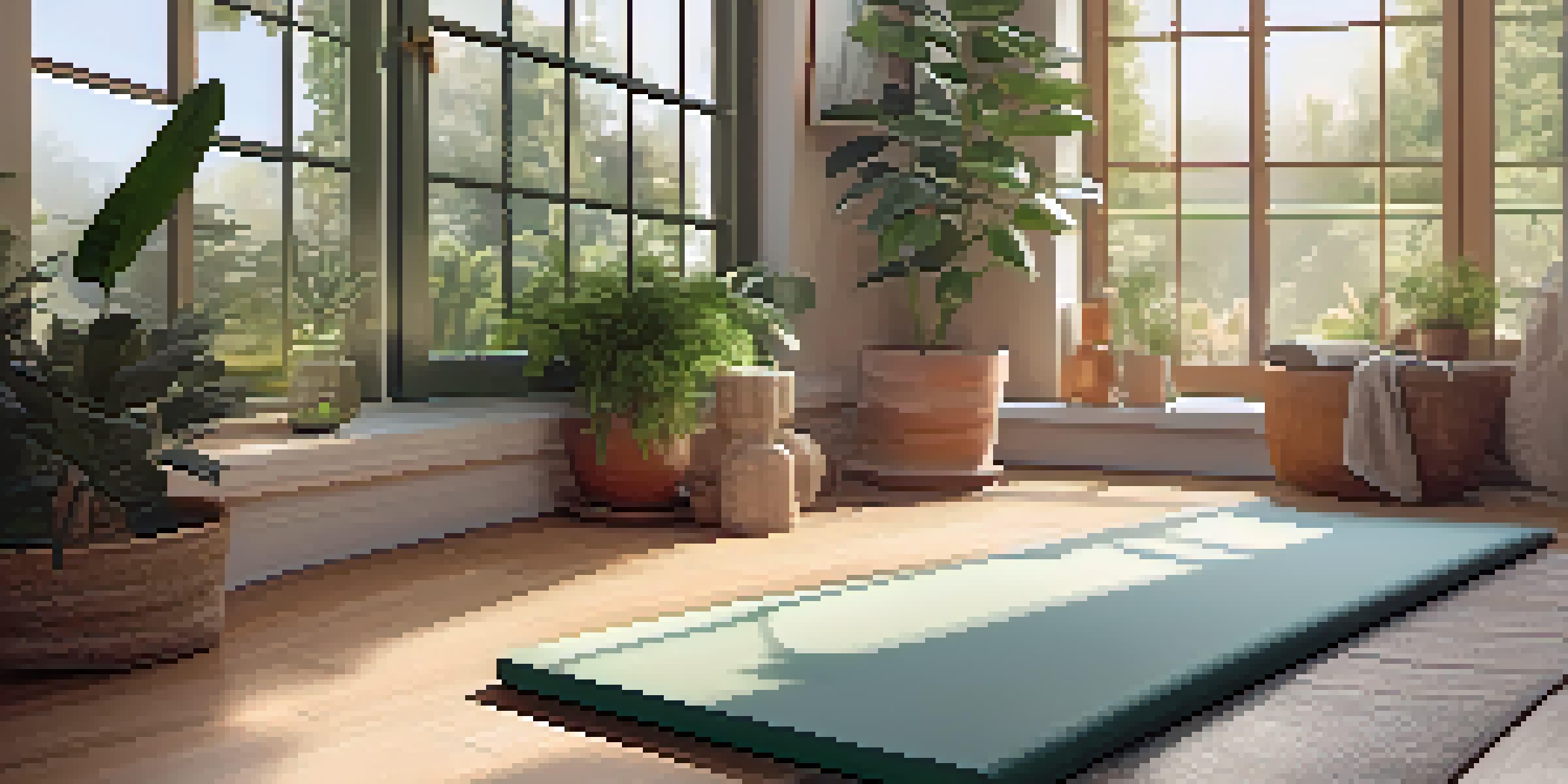Creating a Restorative Yoga Space for Deep Relaxation

Understanding the Importance of a Restorative Space
Creating a restorative yoga space is essential for achieving deep relaxation. When you have a dedicated area, it signals your mind and body that it’s time to unwind. Think of it as a sanctuary where stress melts away and calmness prevails.
Yoga is not about touching your toes, it is what you learn on the way down.
A well-designed space can enhance your yoga practice by minimizing distractions and promoting focus. Imagine coming home to a cozy nook that invites you to pause and breathe deeply. This is the power of your surroundings on your mental well-being.
Incorporating elements that soothe your senses will help you cultivate this environment. Soft lighting, soothing colors, and comfortable props can transform an ordinary room into a haven of tranquility.
Choosing the Right Location for Your Yoga Space
Location plays a crucial role in creating your restorative yoga space. Ideally, you should choose a quiet area of your home that feels secluded from daily distractions. This could be a spare room, a cozy corner in your living room, or even a spot in your garden.

Consider the amount of natural light that the space receives. Natural light can elevate your mood and create a warm, inviting atmosphere. If a room lacks windows, you can mimic this effect with soft, warm lighting to create a similar vibe.
Create a Tranquil Yoga Space
Designing a dedicated, calming area for yoga enhances relaxation and focus during practice.
Lastly, think about the flooring. A soft surface, like carpet or a yoga mat, can provide comfort during your practice. Hard surfaces can be harsh on your body, especially during restorative poses that require stillness.
Creating a Calming Color Palette
The colors you choose for your yoga space can significantly impact your mood and relaxation levels. Soft, muted tones like pastels or earthy colors can evoke feelings of peace. Think of how a serene blue sky or a gentle green forest makes you feel; these colors can replicate that effect indoors.
Nature does not hurry, yet everything is accomplished.
You can also use color psychology to enhance your experience. For instance, light blues are calming, while soft greens can rejuvenate your spirit. Painting your walls or adding artwork in these hues can create a nurturing environment.
Don't forget about accents! Throw pillows, blankets, and curtains in complementary shades can bring warmth and comfort to your space. These touches not only add visual appeal but also create a cohesive, inviting atmosphere.
Incorporating Natural Elements into Your Space
Bringing nature indoors can significantly enhance your restorative yoga experience. Plants, for example, can purify the air and provide a sense of tranquility. Even a small succulent or a larger potted plant can make your space feel more alive and welcoming.
You can also consider using natural materials in your decor. Wooden shelves, bamboo mats, or cotton fabrics can all contribute to a more organic feel. These elements create a sense of harmony and connection to the earth, which is vital for relaxation.
Incorporate Natural Elements
Using plants and natural materials in your yoga space fosters a sense of tranquility and connection to nature.
To take it a step further, consider incorporating natural scents. Essential oils or incense can transform your space into a sensory retreat. Scents like lavender and sandalwood are particularly effective in promoting relaxation and grounding your energy.
Selecting the Right Yoga Props for Comfort
Having the right yoga props can make a significant difference in your restorative practice. Items like bolsters, blankets, and straps can provide the support you need to fully relax into each pose. Think of them as your allies in achieving comfort and ease.
You might also want to include an eye pillow or a soft mat to enhance your experience. These props help create a cocoon-like feeling, allowing you to let go of tension and sink into a deeper state of relaxation. It’s all about finding what feels right for you.
Additionally, don’t shy away from personalizing your props. Choose colors and textures that resonate with you. This connection can enhance your practice and create a more intimate atmosphere in your space.
Creating a Relaxing Soundscape
Sound can profoundly affect your state of mind, so consider curating a relaxing soundscape for your yoga space. Soft music, nature sounds, or even silence can help you dive deeper into your practice. Think about what helps you feel calm and centered.
You might also explore using a sound bowl or gentle chimes to enhance your practice. These can provide a soothing auditory experience that complements your movements and breathing. It’s like inviting a gentle rhythm into your space.
Personalize for Deeper Connection
Adding meaningful decor and personal touches creates a unique space that enhances your yoga experience.
If you prefer silence, ensure your environment is free from noise pollution. Soundproofing elements, like thick curtains or rugs, can help create a serene atmosphere. Your focus should solely be on your breath and body, free from external interruptions.
Personalizing Your Space with Meaningful Decor
Adding personal touches to your yoga space can make it feel more inviting and special. Consider displaying items that inspire you, like photographs, crystals, or meaningful quotes. Each piece can serve as a reminder of your intentions and aspirations.
You could also include a small altar or a dedicated area for meditation. This could house candles, incense, or any items that resonate with your spiritual journey. It’s a beautiful way to create a sacred space for reflection and growth.

Remember, the goal is to foster an environment that feels uniquely yours. The more personal the space, the more connected you will feel to your practice. This connection can lead to deeper relaxation and a more fulfilling yoga experience.